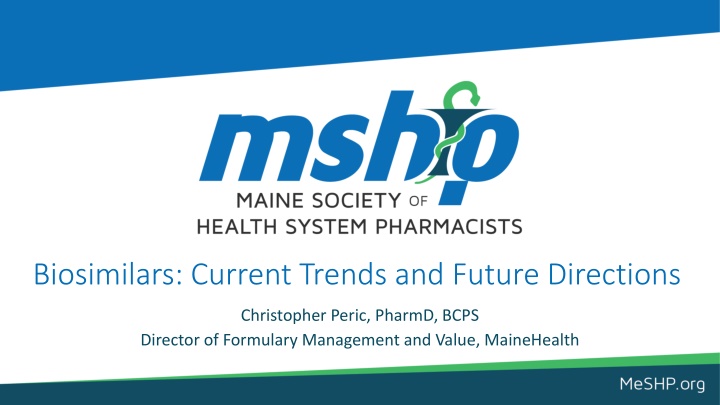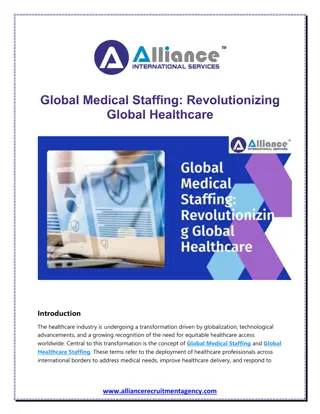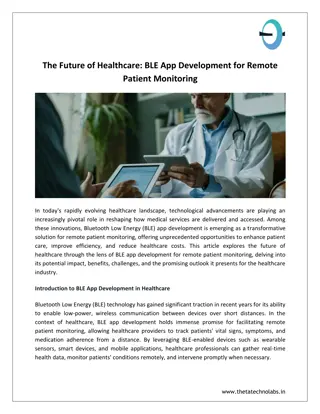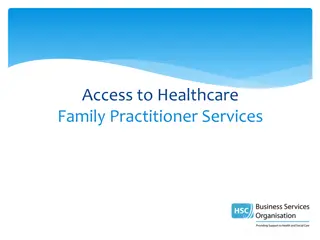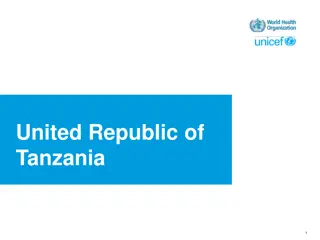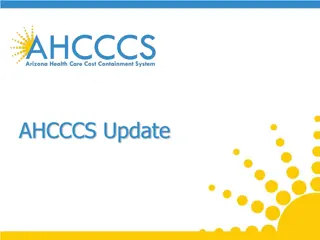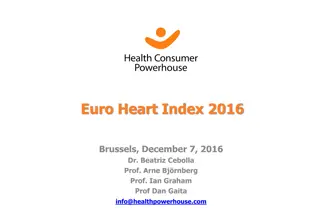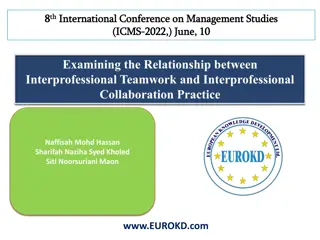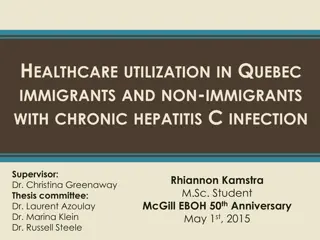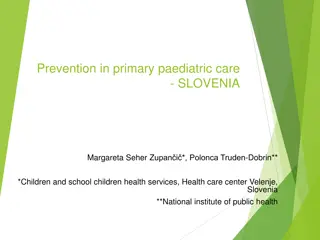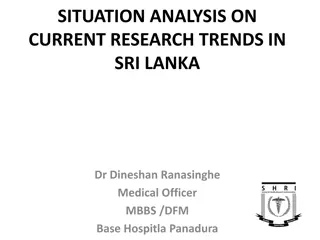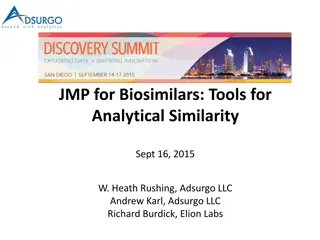Biosimilars in Modern Healthcare: Trends and Insights
Exploring the landscape of biosimilars, this content delves into the regulatory aspects, interchangeability, formulary management, and future implications of these biologic alternatives. With a focus on the dominance of biologics in the market, comparisons with small molecule drugs, and the complexities of manufacturing processes, this piece provides a comprehensive view of the evolving pharmaceutical sector.
Download Presentation

Please find below an Image/Link to download the presentation.
The content on the website is provided AS IS for your information and personal use only. It may not be sold, licensed, or shared on other websites without obtaining consent from the author.If you encounter any issues during the download, it is possible that the publisher has removed the file from their server.
You are allowed to download the files provided on this website for personal or commercial use, subject to the condition that they are used lawfully. All files are the property of their respective owners.
The content on the website is provided AS IS for your information and personal use only. It may not be sold, licensed, or shared on other websites without obtaining consent from the author.
E N D
Presentation Transcript
Biosimilars: Current Trends and Future Directions Christopher Peric, PharmD, BCPS Director of Formulary Management and Value, MaineHealth
Statement of Disclosure I have no conflicts of interest
Objectives Review biosimilar regulatory and development pathways. Identify which biosimilars can be interchanged in both inpatient and outpatient settings. Describe current formulary management approaches for biosimilars. Discuss clinical and financial considerations for future biosimilar use.
Biologics Dominate the Market Biologics represent 8 of the top 10 drugs by expenditure in nonfederal hospitals and clinics in 2018 Spending on specialty drugs in 2018 was $217.7 billion for all sectors, which was 45.7% of total prescription drug expenditures. Biologics and cancer drugs contribute to the majority of increase in spending in hospitals and clinics Schumock GT, et al. Am J Health-Syst Pharm. 2019;76:1105-1121
Small Molecule Drug vs. Biological Products Small Molecule Drug Biological Products Complex proteins taking on primary, secondary, tertiary and quaternary structures Relatively simple, known chemical structures Usually organic or chemical synthesis Made with/from live cells/organisms Possible to demonstrate that the generic version contains the identical active ingredients as the reference product Pharmacologic characteristics depend on specific sequence of amino acids Manufactured through many complex and critical process steps Manufactured with fewer critical steps Examples: Aspirin, Lisinopril Examples: Filgrastim, Infliximab
Manufacturing Differences Complex manufacturing processes which are often proprietary Product characterization may be subject to changes in manufacturing process Many drugs we use have undergone significant changes in the manufacturing process since FDA approval If identical structure can not be replicated, how can follow-on biologics get approved? Schneider CK. Ann Rheum Dis. 2013;72:315-318. Mehr ST. Am Health Drug Benefits.2016;9(9):515-518.
New Licensing Pathway The Biologics Price Competition and Innovation Act of 2009 (BPCI) was passed as part of the Affordable Care Act in 2010 Created an abbreviated licensure pathway for biological products shown to be biosimilar to, or interchangeable with, an FDA-licensed reference product This licensure pathway permits a biosimilar biological product to be licensed under 351(k) of the Public Health Service Act (PHS Act) based on less than a full complement of product-specific preclinical and clinical data abbreviated licensure pathway This pathway was established as a way to provide more treatment options, increase access to lifesaving medications, and potentially lower health care costs through competition. Overview of the Regulatory Framework and FDA s Guidance for the Development and Approval of Biosimilar and Interchangeable Products in the US https://www.fda.gov/media/113820/download. Accessed 10/28/19.
What is a Biosimilar? A biosimilar is a biological product that is highly similar to the FDA-approved reference product notwithstanding minor differences in clinically inactive components; AND There are no clinically meaningful differences between the biological product and the reference product in terms of safety, purity, and potency of the product. Generally demonstrated through human pharmacokinetics (exposure) and pharmacodynamics (response) studies, clinical immunogenicity assessment, and if needed, additional clinical studies Overview of the Regulatory Framework and FDA s Guidance for the Development and Approval of Biosimilar and Interchangeable Products in the US https://www.fda.gov/media/113820/download. Accessed 10/28/19.
Key Definitions Generic drug A drug product that is comparable to a brand/reference listed drug product in dosage form, strength, route of administration, quality and performance characteristics, and intended use Biological products Regulated by the FDA and are used to diagnose, prevent, treat, and cure diseases and medical conditions Generally large, complex molecules Slight differences (acceptable within-product variations) between manufactured lots of the same biological product are normal and expected within the manufacturing process Reference product A single biological product, already approved by the FDA, against which a proposed biosimilar product is compared Overview of the Regulatory Framework and FDA s Guidance for the Development and Approval of Biosimilar and Interchangeable Products in the US https://www.fda.gov/media/113820/download. Accessed 10/28/19.
FDA Biologic Approval Pathway Comparison 351(a): Biologic Reference Product Stand-alone development Drug development starts with preclinical research, moves to Phase 1, 2 and culminates in Phase 3 pivotal trials to show safety and efficacy Goal: Establish safety and efficacy of a new product 351(k): Biosimilar Totality-of-the-evidence approach A stepwise approach to generating data to support biosimilarity No one pivotal study that demonstrates biosimilarity Goal: To demonstrate biosimilarity to reference product, not to independently establish safety and efficacy of proposed product Additional Clinical Studies Clinical Safety and Efficacy Clinical Pharmacology Clinical Pharmacology Pre-Clinical Pre-clinical Analytical Analytical Overview of the Regulatory Framework and FDA s Guidance for the Development and Approval of Biosimilar and Interchangeable Products in the US https://www.fda.gov/media/113820/download. Accessed 10/28/19.
FDA Totality-of-the-evidence Clinical study to compare immunogenicity Comparative clinical study to assess clinically meaningful differences Necessary if there are residual uncertainties about differences based on previous assessments Utilize clinically relevant endpoints (population, sample size, study duration) Additional Clinical Studies Comparative human PK/PD data to assess clinically meaningful differences PK/PD generally considered the most sensitive clinical study in which to assess for differences Supports a demonstration of biosimilarity with the assumption that similar exposure (and pharmacodynamics response) provides similar efficacy and safety Clinical Pharmacology Animal toxicity data useful when uncertainties remain about safety Scope and extent of studies depends on available information and/or data submitted in the biosimilar application Comparison of PK/PD in an animal model may be useful Pre-clinical Foundation of the biosimilar development program Involves extensive structural and functional characterization Identification of critical quality attributes and clinically active components Evaluate potential effect of differences on safety, purity, and potency Analytical Overview of the Regulatory Framework and FDA s Guidance for the Development and Approval of Biosimilar and Interchangeable Products in the US https://www.fda.gov/media/113820/download. Accessed 10/28/19.
FDA Biosimilar Application A biosimilar application must include information demonstrating that the product: Is biosimilar to the reference product Utilizes the same mechanism(s) of action for the proposed condition(s) of use but only to the extent the mechanism(s) are known for the reference product Condition(s) of use proposed in the labeling have been previously approved for the reference product Has the same route of administration, dosage form, and strength as the reference product Is manufactured, processed, packaged, and held in a facility that meets standards designed to assure that the biologic product continues to be safe, pure, and potent Overview of the Regulatory Framework and FDA s Guidance for the Development and Approval of Biosimilar and Interchangeable Products in the US https://www.fda.gov/media/113820/download. Accessed 10/28/19.
Extrapolation of Indications Use of data derived from a clinical study of a biosimilar in one indication to support the licensing of the biosimilar for other approved uses of the reference biologic Based on all available data and information in biosimilar application and FDA s previous finding of safety and efficacy for other approved indications for the reference product Must be scientifically justified and is predicated on the level of understanding of many factors including: Mechanism of action in each condition of use Pharmacokinetics and bio-distribution in different patient populations Immunogenicity and toxicity profiles in different patient groups Biosimilar Product Regulatory Review and Approval. https://www.fda.gov/media/108621/download. Accessed 10/28/19.
Interchangeability Interchangeable or Interchangeability means: the biological product is biosimilar to the reference product; it can be expected to produce the same clinical result as the reference product in any given patient; and for a product that is administered more than once to an individual, the risk in terms of safety or diminished efficacy of alternating or switching between use of the product and its reference product is not greater than the risk of using the reference product without such alternation or switch. Note: The interchangeable product may be substituted for the reference product without the intervention of the health care provider who prescribed the reference product. Biosimilar Product Regulatory Review and Approval. https://www.fda.gov/media/108621/download. Accessed 10/28/19.
Interchangeability Application In May 2019, FDA published final guidance document for industry on how to demonstrate interchangeability with a reference product Focus on dedicated switching studies utilizing reference product PK/Endpoint Sampling1 Lead-in Period Switching Period Non-Switching Arm Reference Product Reference Product Reference Biosimilar Switching Arm Biosimilar Adequate Washout Considerations in Demonstrating Interchangeability with A Reference Product: Guidance for Industry https://www.fda.gov/regulatory-information/search-fda-guidance-documents/considerations-demonstrating-interchangeability-reference-product-guidance-industry. Accessed 10/28/19.
Interchangeability Current State To date, no biosimilar product has been designated as interchangeable by the FDA May be pursued for future products to improve market share over multiple competitors Once product is designated as interchangeable by the FDA, individual states will be responsible for regulating substitution Sounds great! What about Maine? Biosimilar Product Regulatory Review and Approval. https://www.fda.gov/media/108621/download. Accessed 10/28/19.
Interchangeability in Maine STATE OF MAINE IN THE YEAR OF OUR LORD TWO THOUSAND NINETEEN H.P. 480 - L.D. 659 An Act Regarding the Use of Interchangeable Biological Products Except with regard to a patient who is paying for a drug or biological product with the patient's own resources, if a written prescription issued by a practitioner in this State does not contain the box described in this section, a pharmacist shall substitute a generic and therapeutically equivalent drug for the drug or an interchangeable biological product for the biological productspecified on the prescription This section does not apply to prescriptions ordered by practitioners for patients in hospitals when those prescriptions are filled by a hospital pharmacy or in any institution where a formulary system is established. An Act Regarding the Use of Interchangeable Biologial Products. H.P. 480 L.D. 659. State of Maine. 2019
Regulatory Summary Goal of abbreviated pathway: To establish biosimilarity between the proposed biosimilar and reference product, not to re-establish safety and effectiveness. Biosimilar must demonstrate it is highly similar to and has no clinically meaningful differences from its reference product No need to demonstrate efficacy in all indications Interchangeability designation still in development How are health systems managing biosimilars as part of their formularies? Overview of the Regulatory Framework and FDA s Guidance for the Development and Approval of Biosimilar and Interchangeable Products in the US https://www.fda.gov/media/113820/download. Accessed 10/28/19.
Formulary Management Approaches Vizient Pharmacy Network conducted survey of member institutions in July 2019 to determine formulary approaches to biosimilars (26 respondents) Single Entity 8% (2) Nonacademic Medical Center 15% (4) Academic Medical Center 85% (22) Health System 92% (24)a a77% (20 of 24 respondent health systems) reported a single system formulary Biosimilars and Formulary Management. Vizient Pharmacy Network Survey Results. July 2019.
Vizient Survey Type of Formulary Review Biosimilars and Formulary Management. Vizient Pharmacy Network Survey Results. July 2019.
Vizient Survey Automatic Interchange 81% (21 of 26 institutions) reported at least one biosimilar with an automatic therapeutic interchange during inpatient admission 27% (7 of 26 institutions) provided commentary on payer mandates determining outpatient product use Biosimilars and Formulary Management. Vizient Pharmacy Network Survey Results. July 2019.
MaineHealth Experience Added several biosimilar products to system formulary over time Predicting large amount of biosimilar releases over next 2-3 years Opportunities for contract enhancements through group purchasing organization Need to adapt to variations in payor coverage and reimbursement No system-wide Pharmacy and Therapeutics Committee for decision-making
P&T Committee Review Evolution Biosimilar Therapeutic Equivalence Individual Drug Review Drug Class Review Growing number of FDA approved products, including multiple within single class Several years of experience in clinical practice Increased comfort and knowledge from providers, increasing payer acceptance, improved reimbursement Process manageable for marketed products but logistics difficult for products anticipating release or when negotiating improved pricing Frequent FDA approvals, anticipating highly competitive market FDA establishing and promoting guidelines for interchangeability Expansion in product development bridging inpatient and outpatient settings Process to allow early adoption of biosimilar products to increase access and rapidly realize cost savings Small number of FDA approved products No prior experience with biosimilars in U.S. Limited knowledge of provider and payer acceptance or reimbursement models Early stages of development for FDA review and naming process Process manageable for single agents within class or with infrequent release of new products
Biosimilar Formulary Approach Biosimilar drugs considered therapeutically equivalent to the reference drug for the biosimilar s FDA approved indications (inpatient and outpatient infusion settings) Selection of a preferred formulary biologic agent within a therapeutic class (reference product or biosimilar to the reference product) will be determined by the MaineHealth Pharmacy Enterprise Council based on cost-effectiveness Pharmacy will communicate with key stakeholders prior to any preferred biologic change
Biosimilar Formulary Approach Patients on active therapy with a non-preferred formulary biologic may be continued on original therapy if provider desires Alternatives to the preferred agent will be reviewed with the provider in the following scenarios: Patients have a documented, severe reaction or allergy to a component of a preferred biosimilar agent Patients continuing existing treatment with a non-preferred formulary biologic Patient s insurance denies coverage of the preferred agent Providers will have the option to request a formal review of an individual biosimilar product by the P&T Committee
Challenges Remain Patient education and approach Payor coverage and reimbursement Medicare vs. Commercial Coverage differs by commercial payor, by biosimilar class, by manufacturer Cost analysis models GPO vs. 340B, orphan drug status, DSH vs. Sole Community vs. Critical Access Provider education and comfort in varying patient populations
Biosimilars in Oncology American Society of Clinical Oncology published a position statement in April 2018 Biosimilars will play an important role in the future care of patients with cancer and will improve access to valuable medicines. This statement affirms ASCO s commitment to ensure the availability of biologics that are necessary in the delivery of high-quality, high-value care. To enhance patient and provider confidence in biosimilars, it is necessary to educate oncology providers and continue to advocate for federal and state policies that ensure the efficient approval, unrestricted access, and appropriate use of biosimilars. Lyman GH. J Clin Oncol. 2018;36:1260-1265.
Biosimilars in Rheumatology American College of Rheumatology published white paper in March 2018 The initial position of the ACR on biosimilars supported the rationale behind pursuing biosimilars, but urged caution as they were being developed, evaluated, and approved. Now that biosimilars have been used successfully in Europe, with rigorously acquired data supporting their broader use, and as the US is on the verge of a similar transition, the ACR is poised to reconsider its position. During this period of transition, it is reassuring to recognize the scientific rigor with which the FDA and other regulatory agencies around the world have evaluated biosimilars. Health care providers should now incorporate biosimilars, where appropriate, into regimens to treat patients with rheumatologic diseases. Bridges SL, et al. Arthritis Rheumatol. 2018;70(3):334-344.
Biosimilars in Gastroenterology American Gastroenterological Association published Clinical Practice Update in April 2019 Provided that the regulatory pathway remains rigorous and postmarketing surveillance is performed adequately, clinicians and patients can be reassured that these agents will provide the same well-described effectiveness for moderate-to-severe CD and UC without new safety concerns. Position statement from Crohn s and Colitis Foundation The Foundation is not opposed to single transitions of stable patients from an originator to a biosimilar (or vice versa) by third parties (payers or pharmacies), but is opposed to multiple switches if the agents involved have not been designated as interchangeable by the FDA. Raffals LE, et al. Clin Gastoenterol Hepatol. 2019;17:818-823. Crohn s and Colitis Foundation. Biosimilars Position Statement. Accessed 10/30/19
Clinical Impact Single Switches Several post-marketing studies published evaluating transition from reference infliximab to biosimilar infliximab Patient population included Crohn s disease and inflammatory bowel disease Follow-up period in studies ranged from 16-52 weeks Majority of evidence demonstrates no decrease in efficacy or increased immunogenicity in patients switched to biosimilar Emphasis on need for clear communication between patients, providers, and pharmacy Raffals LE, et al. Clin Gastoenterol Hepatol. 2019;17:818-823. Rudrapatna VA, et al. Pract Gastroenterol. 2019;43(4):84-91.
FDA Biosimilars Currently Available Product Manufacturer Date Approved Date Marketed Zarxio (filgrastim-sndz) Sandoz March 2015 September 2015 Inflectra (infliximab-dyyb) Celltrion/Pfizer April 2016 November 2016 Renflexis (infliximab-abda) Samsung Bioepis/Merck April 2017 July 2017 Retacrit (epoetin alfa-epbx) Pfizer May 2018 November 2018 Fulphila (pegfilgrastim-jmdb) Mylan June 2018 July 2018 Nivestym (filgrastim-aafi) Pfizer July 2018 October 2018 Udenyca (pegfilgrastim-cbqv) Coherus November 2018 January 2019 Mvasi (bevacizumab-awwb) Amgen/Allergan September 2017 July 2019 Kanjinti (trastuzumab-anns) Amgen June 2019 July 2019 FDA Biosimilar Product Information https://www.fda.gov/drugs/biosimilars/biosimilar-product-information. Accessed 7/1/19.
FDA-Approved: Awaiting Launch Product Manufacturer Erelzi (etanercept-szzs) Amjevita (adalimumab-atto) Cyltezo (adalimumab-adbm) Boehringer Ingelheim Ogivri (trastuzumab-dkst) Ixifi (infliximab-qbtx) Hyrimoz (adalimumab-adaz) Truxima (rituximab-abbs) Herzuma (trastuzumab-pkrb) Ontruzant (trastuzumab-dttb) Trazimera (trastuzumab-qyyp) Eticovo (etanercept-ykro) Samsung Bioepis/Merck Zirabev (bevacizumab-bvzr) Ruxience (rituximab-pvvr) Hadlima (adalimumab-bwwd) Samsung Bioepis/Merck Date Approved August 2016 September 2016 August 2017 December 2017 December 2017 October 2018 November 2018 December 2018 January 2019 March 2019 April 2019 June 2019 July 2019 July 2019 Anticipated Release TBD January 2023 July 2023 Q3-4 2019 TBD January 2023 2020 Q3-4 2019 Q3-4 2019 Q3-4 2019 TBD December 2019 TBD 2023 Sandoz Amgen Mylan Pfizer Sandoz Celltrion Teva Merck Pfizer Pfizer Pfizer 33 FDA Biosimilar Product Information https://www.fda.gov/drugs/biosimilars/biosimilar-product-information. Accessed 7/1/19.
Insulin Development The Biologics Price Competition and Innovation Act of 2009 (BPCI) requires insulin products to be licensed as a biological product under section 351 of PHS Act on March 23, 2020 Opens pathway for biosimilars to currently approved insulin products Goal is to promote competition in order to provide better medication access Dead Zone and Gap Year Interchangeability will not be granted immediately, must be biosimilar first George K, et al. BioDrugs 2019;33:447-451. Interpretation of the Deemed to be a License Provision of the Biologics Price Competition and Innovation Act of 2009. https://www.fda.gov/media/119590/download. Accessed 10/28/19.
Government Affairs Several bills being discussed that will impact future biosimilar use Many bills include biosimilars as part of strategy to improve drug affordability, remove barriers to entry, and improve reimbursement
Industry: Shifting Focus Biosimilar investment vs. innovation New drugs coming to market may replace existing therapies Upadacitinib, ravulizumab New indications to existing products Innovation with device design Recent study showed patients and nurses preferred and recommended autoinjector for etanercept biosimilar over reference products for treatment of rheumatoid arthritis PBM formulary status and payment structure Tischer B, Mehl A. Patient Prefer Adherence. 2018;2(12):1413-1424. RM Fleischmann, et al. Ann Rheum Dis. 2019;78:1454-1462 Ultomiris [Package Insert]. Boston, MA. Alexion Pharmaceuticals Inc. 2018.
Provider Education Provider comfort with biosimilars still a challenge Concern with lack of clinical data in specific populations (i.e. extrapolation) Potential Solutions Frequent engagement with stakeholders in anticipation of new biosimilar products Continual review of approval process, PK/PD data, experiences thus far with biosimilars Post-marketing clinical data in specific populations, single switch studies Transparency with regards to payor and reimbursement implications, potential patient impacts Forecasting development pipeline (FDA vs. EMA)
Patient Education FDA recently released patient education materials
Summary Biosimilar regulatory pathways focused on totality-of-evidence approach Formulary management of biosimilars continue to evolve in health system settings, with shift towards alternative review models to expedite decision-making Growing body of clinical evidence for individual biosimilar products to support therapeutic equivalence and single switching Drug development pipeline, payor strategies, provider/patient education, and health care policy will play large role in biosimilar landscape
Biosimilars: Current Trends and Future Directions Christopher Peric, PharmD, BCPS Director of Formulary Management and Value, MaineHealth
